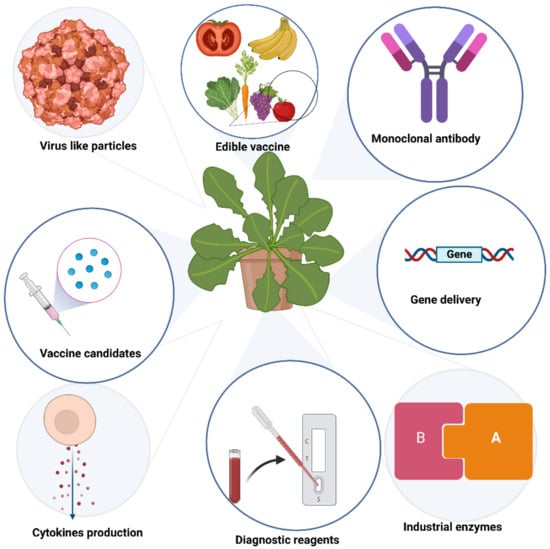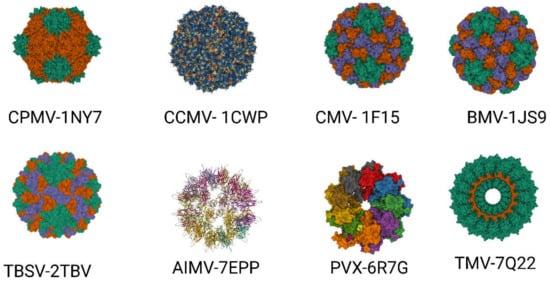Your browser does not fully support modern features. Please upgrade for a smoother experience.
Please note this is an old version of this entry, which may differ significantly from the current revision.
Subjects:
Biochemistry & Molecular Biology
Plant viruses have traditionally been studied as pathogens in the context of understanding the molecular and cellular mechanisms of a particular disease affecting crops. In recent years, viruses have emerged as a new alternative for producing biological nanomaterials and chimeric vaccines. Plant viruses were also used to generate highly efficient expression vectors, revolutionizing plant molecular farming (PMF).
- plant molecular farming
- virus-like particles (VLPs)
- protein cages
- plant-derived vaccines
- biologics
- nanomedicine
- viral-based nanotechnology
- drug delivery
- immune therapy
1. Introduction
Since plant viruses were discovered in the late nineteenth century, their impact has changed from harmful pathogens to useful molecular machines with applications in plant molecular farming (PMF) and bio-nanotechnology. Although public perception of a “virus” is often associated with harm, viruses can easily be reorganized into environmentally friendly and safe structures [1,2,3]. The expansion of the overall knowledge and understanding of viral genomes, architecture, and biophysical properties has allowed the use of plant viruses as vectors for recombinant protein expression and the production of virus-based nanoparticles (VNPs) [4]. VLPs are self-assembled, naturally occurring nanomaterials that structurally and morphologically resemble the 3-dimensional structures of virions, but without the viral genome. VLPs modified to carry additional useful payload are defined as VNPs. Some of the many biological applications of VNPs, which are generated from the capsid structural components of various viruses, include vaccine production and innovative delivery mechanisms for therapeutic compounds, diagnostic reagents, enzymes, pesticides, immunogenic peptides, and many others [5].
Historical Review of Plant Molecular Farming
Over the past three decades, several plant systems have been used to produce recombinant proteins. Much interest has been paid to plant-derived antibodies, vaccines, enzymes, microbicides, and viral protein nanocages (Figure 1).

Figure 1. Biologics produced in plants.
Plant molecular farming was born in 1980 when the marker gene for β-glucuronidase (GUS) was successfully transformed in higher plants [6]. Later, β-glucuronidase became one of the successful commercial products of plant molecular farming, together with two other industrial enzymes, avidin and trypsin [7,8,9]. In 1986, human growth hormone (HGH) was produced in transgenic tobacco and sunflowers [10]. In 1988, the first production of human antibodies in plants was reported [11]. The concept of using plants for the production of vaccines, more specifically, edible vaccines, was introduced by Dr. Charles Arntzen in the 1990s [12]. Studies were focused on this topic for many years [13,14,15] until the incident of seed contamination with a transgene expressing a bovine vaccine candidate [16,17]. The new trends in plant molecular farming are to use plants in controlled conditions to produce recombinant products that can either be injected or used orally [18,19,20,21,22].
The initial plant-derived biopharmaceuticals were expressed in stable transgenic plants. This technological approach has three main disadvantages: a long developmental period, low yield, and public concerns about GMO plants. Transient expressions via plant expression virus vectors offer a way to avoid these limitations [23].
Although the production of recombinant proteins in plants by stable gene integration and expression has some limitations, the initial commercialized therapeutic recombinant proteins were produced by this technology. In 2006, stably transformed N. benthamiana cell cultures were used for the production of the first USDA-approved injectable vaccine against the Newcastle disease virus for poultry [24]. In 2012, the FDA approved plant-derived recombinant human β-glucocerebrosidase (marketed as Elelyso®) for the treatment of Gaucher’s disease type 1. The recombinant human β-glucocerebrosidase enzyme was produced in a stably transformed carrot cell suspension culture by Protalix Biotherapeutics Inc. [25] and licensed to Pfizer. In 2022, Health Canada approved the first plant-derived SARS-CoV-2 vaccine, Covifenz [26]. The strategy included transient expression in N. benthamiana of the modified recombinant SARS-CoV-2 S protein with stabilizing point mutations. Medicago Inc. successfully produced and purified modified SARS-CoV-2 S VLPs built from the S protein. Using the same technology, Medicago Inc. successfully produced a vaccine against seasonal influenza [27]. Currently, there are few examples of commercialized plant molecular farming products, and plants cannot replace industrial expression systems. However, PMF has been proven cost-effective and valuable in the production of vaccines, antibodies, enzymes, and biological VNPs under conditions of urgency, such as emerging pandemic viruses or for treating rare diseases.
2. Important Plant Viruses for Plant Biotechnology
Approximately 900 plant viruses, identified mainly in crops, are known [28]. Several of them, such as the tobacco mosaic virus (TMV), potato virus X (PVX), cowpea mosaic virus (CPMV), cowpea chlorotic mottle virus (CCMV), brome mosaic virus (BMV), cucumber mosaic virus (CMV), plum pox virus (PPV), alfalfa mosaic virus (AIMV), papaya mosaic virus (PapMV), tomato bushy stunt virus (TBSV), and many others, are utilized in biotechnology and plant viral-based nanotechnology research and industry (Figure 2) [29,30].

Figure 2. Important plant VLPs with application in biotechnology and plant viral-based nanotechnology. Plant viruses with their corresponding protein databank identification number—CPMV (PDB ID: 1NY7), CCMV (PDB ID: 1CW7), CMV (PDB ID: 1F15), BMV (PDB ID: 1JS9), TBSV (PDB ID: 2TBV), AIMV (PDB ID: 7EPP), PVX (PDB ID: 6R7G), TMV (PDB ID: 7Q22).
Plant viruses have very simple (rod-shaped, spherical, quasi-spherical, or filamentous) structures, consisting of multiple copies of one or a few capsid protein subunits, forming a protein coat around the viral genome. The capsid proteins have the ability to self-assemble, which offers the opportunity to generate a great variety of natural bio-nanomaterials. A better understanding of the structure and biophysical characteristics of plant viruses is vital for developing and producing VNPs, which can be used as nanoparticles for the surface presentation of antigens for recombinant VNP vaccines or as nanocages for “cargo” delivery. VNPs are naturally occurring biological entities, making them both biocompatible and biodegradable. Furthermore, VNPs can be targeted to particular tissue or cells. Finally, the production and purification of VNPs from plants are rapid, cost-effective, and environmentally safe (compared with conventional nanoparticles) and can easily be scaled up depending on demand [31]. There are two main strategies for VNPs production in plants: using a virus infection, allowing the cultivation of plant viruses in their natural host, or the biotechnology approach, using transient expression of the viral genes encoding the capsid proteins in heterologous expression systems [32,33,34].
2.1. Tobacco Mosaic Virus (TMV)
TMV is a member of the genus Tobamovirus in the family of Virgaviridae. TMV has a rod-shaped virion with a diameter of 18 nm, a modal length of 300 nm with a central channel in width, and the viral RNA intercalated between the coat protein turns [35]. TMV coat protein (CP) could self-assemble into the form of a rigid helical RNA-free tube [36]. Tobacco mosaic virus can be easily cultivated in plants, and the yields can be very high, ~4 g/kg wet weight of tobacco. The purified TMV rod-shaped virions can be disassembled in vitro into protein subunits and RNA [37,38]. When nucleic acid is absent, the coat protein can self-assemble into several types of VNPs. The polymerization of the TMV coat protein is temperature and concentration-dependent [39,40]. TMV VNPs are stable and can be used as scaffolds for chemical modifications, coating with biologically active peptides, or loading with drugs [17,41,42,43,44,45,46]. TMV has been widely used as a full-vector and also as a deconstructed virus vector for recombinant protein expression [47].
2.2. Cowpea Mosaic Virus (CPMV)
CPMV belongs to the genus Comovirus in the Comoviridae family. It is a non-enveloped, icosahedral virus with nanoscale dimensions (30 nm). The CPMV protein shell is comprised of 60 copies of the large (L) coat proteins with two domains and 60 copies of the small (S) coat proteins with one domain [48]. The three domains together form the asymmetric unit of the CPMV capsid, with 2 nm channels enabling the exchange of molecules from the exterior to the interior. The internal viral cavity encapsulates two single-stranded RNA molecules [49,50].
This CPMV virus has been widely used in bio-nanotechnology because its structure and particle architecture have been well studied, and the genome can easily be manipulated [51]. Virus particles, which contain viral genomic RNAs, can be produced rapidly in high yield (1–2 g/kg) through the infection of plants [48]. These viral particles have been used for selective attachment of various moieties [51,52,53,54,55] and to display immunogenic epitopes on their surface [56,57]. The drawback is that the CPMV particles containing genomic RNAs raise biosafety and regulatory concerns. They are also ineffective drug containers because they are hard to load with foreign materials such as therapeutic agents or heterologous RNA molecules. Prof. Lomonossoff’s laboratory addressed these problems by developing RNA-free, empty virus-like particles (eVLPs) based on the transient expression of VP60 (precursor of L and S coat proteins) along with the 24K viral proteinase in Nicotiana benthamiana [58,59,60,61]. In addition, the eVLPs are very stable under various conditions, which extends their bio-nanotechnology application range [2,61,62,63]. Lomonossoff’s lab further improved CPMV viral particle packaging, allowing the production of VLPs that can pack up to 6 kb of artificial RNA [64]. Furthermore, CPMV was used for the expression of recombinant proteins by applying full-virus and deconstructed virus strategies [65].
2.3. Cowpea Chlorotic Mottle Virus (CCMV)
CCMV belongs to the Bromoviridae family. The CCMV capsid is composed of 180 identical capsid proteins (CP) that form a ~28 nm diameter icosahedral shell and an 18 nm diameter inner cavity [66]. Native CCMV is stable at pH 5.0. The native CCMV virion can be disassembled, and the RNA genome can be removed by centrifugation under high salt concentrations at neutral pH [67]. In vitro, at pH 5.0, the CCMV capsid proteins can be self-assembled into empty nanoscale structures [68]. CCMV is one of the first viruses used in bio-nanotechnology as a tool for developing drug-delivery vehicles due to its well-studied structure, simple capsid with good biocompatibility, and low toxicity [69]. VNPs based on CCMV have been used to encapsulate guest molecules, such as negatively charged polymers, enzymes, and organic aggregates [70]. A wide variety of ligands, such as small peptides, biotin, fluorescent dyes, organometallic photosensitizers, and intact IgG antibodies, can be attached on the outer surface of the capsid [71,72,73,74].
2.4. Brome Mosaic Virus (BMV)
BMV, a member of the family Bromoviridae, is very similar to CCMV [75]. The native virion has a diameter of 28 nm with T = 3 icosahedral symmetry, and it is built of 180 identical capsid proteins with different conformations (A, B, and C) [76,77]. The A conformation of the coat protein forms pentameric capsomers with small 0.5 nm pores. The B and C conformations of the capsid protein form hexameric capsomer with 0.6 nm pores [76]. The stability of the capsid depends on the interaction between the positively charged inner cavity and the negatively charged encapsulated RNA [78]. BMV, similarly to CCMV, is widely used in bio-nanotechnology due to its well-examined structure and biophysical properties.
This entry is adapted from the peer-reviewed paper 10.3390/ijms24021533
This entry is offline, you can click here to edit this entry!
